Complex Characterization and Behavior of Waste Fired Brick Powder-Portland Cement System
Abstract
1. Introduction
2. Materials and Methods
2.1. Used Materials and Their Characterization
2.1.1. Chemical Characteristics
2.1.2. Physical Characteristics
2.1.3. Mix Proportion and Preparation
2.2. Methods of Testing Fresh and Hardened Pastes
2.2.1. Mini-Slump Test
2.2.2. Frattini Test
2.2.3. The Heat of Hydration Measurement
2.2.4. Specific Density
2.2.5. Compressive Strength
2.2.6. Hydration Monitoring
2.2.7. Pore Size Distribution
3. Results and Discussion
3.1. Workability
3.2. Pozzolanic Activity
3.3. Hydration Heat
3.4. Specific Density and Porosity
3.5. Compressive Strength of Hardened Pastes
3.6. Kinetics of Pozzolanic Reaction and Formed Compounds
4. Conclusions
- Ceramic waste originated in a ceramic factory can be used as a pozzolanic material contributing to the reduction of CO2 emission in cement-based materials.
- The initial mini-slump was not affected for low PC replacement (8% and 16% by mass) but decreased with increasing CW content. The mini-slump loss rate of blended cement had similar value to the corresponding PC.
- The incorporation of CW reduced the heat released during cement hydration up to 48 h without significant changes in the time of occurrence of main hydration peaks.
- CW behaved as a filler at early ages, but when the hydration proceeds, its pozzolanic activity consumed partially the CH and promoted the formation of Afm phases depending on the age and carbonates present. On day 7, the formation of hemicarboaluminate occurred, then it coexisted with the incipient formation of monocarboaluminate, and finally, the monocarboaluminate was the predominant Afm phase.
- Blended cements with CW had low compressive strength at early ages but comparable strength-class at later age. Blended cement pastes containing CW exhibited higher porosity than those of PC paste. However, a reduction in the threshold value for more reactive CW was observed.
- Based on proven pozzolanic activity and low-density of studied powdered red ceramic wastes, their use in mix composition of cement and lime-based composites can be anticipated. The results summarized above indicated that CW could act both as an active mineral admixture and lightweight microfiller for the production of lightweight construction materials.
Author Contributions
Funding
Acknowledgments
Conflicts of Interest
References
- Uddin, F.; Shaikh, A.; Nguyen, H.L. Properties of concrete containing recycled construction and demolition wastes as coarse aggregates. J. Sust. Cem.-Based Mater. 2013, 2, 204–217. [Google Scholar] [CrossRef]
- Kou, S.C.; Poon, S.C. Effects of different kinds of recycled fine aggregate on properties of rendering mortar. J. Sust. Cem.-Based Mater. 2013, 2, 43–57. [Google Scholar] [CrossRef]
- Ben Said, S.E.; Khay, S.E.; Louilizi, A. Experimental investigation of PCC incorporating RAP. Int. J. Concr. Struct. Mater. 2018, 12. [Google Scholar] [CrossRef]
- Akhtar, A.; Sarmah, A.K. Construction and demolition waste generation and properties of recycled aggregate concrete: A global perspective. J. Clean. Prod. 2018, 186, 262–281. [Google Scholar] [CrossRef]
- Monteiro, P.J.M.; Miller, S.A.; Horwath, A. Towards sustainable concrete. Nat. Mater. 2017, 16, 698–699. [Google Scholar] [CrossRef]
- Yu, L.; Zhou, S.; Deng, W. Pozzolanic activity of volcanic rocks from Southern Jiangxi Province, China. J. Sust. Cem.-Based Mater. 2016, 5, 176–198. [Google Scholar] [CrossRef]
- Tan, K.H.; Du, H. Sandless concrete with fly ash as supplementary cementing material. J. Sust. Cem.-Based Mater. 2013, 2, 238–249. [Google Scholar] [CrossRef]
- Záleská, M.; Pavlíková, M.; Pavlík, Z.; Jankovský, O.; Pokorný, J.; Tydlitát, V.; Svora, P.; Černý, R. Physical and chemical characterization of technogenic pozzolans for the application in blended cements. Constr. Build. Mater. 2018, 160, 106–116. [Google Scholar] [CrossRef]
- Hussin, M.W.; Khankhaje, E. Investigation of coal bottom ash and fly ash in concrete as replacement for sand and cement. Constr. Build. Mater. 2016, 116, 15–24. [Google Scholar] [CrossRef]
- Kwan, A.K.H.; Chen, J.J. Adding fly ash microsphere to improve packing density, flowability and strength of cement paste. Powder Technol. 2013, 234, 19–25. [Google Scholar] [CrossRef]
- Chen, J.J.; Ng, P.L.; Li, L.G.; Kwan, A.K.H. Use of superfine zeolite in conjunction with silica fume - Effects on rheology and strength of cementitious paste. Powder Technol. 2018, 328, 75–83. [Google Scholar] [CrossRef]
- Chen, J.J.; Ng, P.L.; Kwan, A.K.H.; Li, L.G. Lowering cement content in mortar by adding superfine zeolite as cement replacement and optimizing mixture proportions. J. Clean. Prod. 2019, 210, 66–76. [Google Scholar] [CrossRef]
- Pavlík, Z.; Fořt, J.; Záleská, M.; Pavlíková, M.; Trník, A.; Medved, I.; Keppert, M.; Koutsoukos, P.G.; Černý, R. Energy-efficient thermal treatment of sewage sludge for its application in blended cements. J. Clean. Prod. 2016, 112, 409–419. [Google Scholar] [CrossRef]
- Cordeiro, G.C.; Sales, C.P. Influence of calcining temperature on the pozzolanic characteristics of elephant grass ash. Cem. Concr. Compos. 2016, 73, 98–104. [Google Scholar] [CrossRef]
- Pavlíková, M.; Zemanová, L.; Pokorný, J.; Záleská, M.; Jankovský, O.; Lojka, M.; Sedmidubský, D.; Pavlík, Z. Valorization of wood chips ash as an eco-friendly mineral admixture in mortar mix design. Waste Manage. 2018, 80, 89–100. [Google Scholar] [CrossRef] [PubMed]
- Jankovský, O.; Pavlíková, M.; Sedmidubský, D.; Bouša, D.; Lojka, M.; Pokorný, J.; Záleská, M.; Pavlík, Z. Study on pozzolana activity of wheat straw ash as potential admixture for blended cements. Ceram.-Silikáty 2017, 61, 327–339. [Google Scholar] [CrossRef]
- Ting, L.; Qiang, W.; Shiyu, Z. Effects of ultra-fine ground granulated blast-furnace slag on initial setting time, fluidity and rheological properties of cement pastes. Powder Technol. 2019, 345, 54–63. [Google Scholar] [CrossRef]
- Aliabdo, A.A.; Abd Elmoaty, A.E.M.; Aboshama, A.Y. Utilization of waste glass powder in the production of cement and concrete. Constr. Build. Mater. 2016, 124, 866–877. [Google Scholar] [CrossRef]
- Liu, S.; Zhang, T.; Guo, Y.; Wei, J.; Yu, Q. Effects of SCMs particles on the compressive strength of micro-structurally designed cement paste: Inherent characteristic effect, particle size refinement effect, and hydration effect. Powder Technol. 2018, 330, 1–11. [Google Scholar] [CrossRef]
- Senhadji, Y.; Escadeillas, G.; Mouli, M.; Khelafi, H.; Benosman. Influence of natural pozzolan, silica fume and limestone fine on strength, acid resistance and microstructure of mortar. Powder Technol. 2014, 254, 314–323. [Google Scholar] [CrossRef]
- Xiao, J.; Ma, Z.; Sui, T.; Akbarnezhad, A.; Duan, Z. Mechanical properties of concrete mixed with recycled powder produced from construction and demolition waste. J. Clean. Prod. 2018, 188, 720–731. [Google Scholar] [CrossRef]
- Cheng, Y.H.; Huang, F.; Liu, R.; Hou, J.-L.; Li, G.-L. Test research on effects of waste ceramic polishing powder on the permeability resistance of concrete. Mater. Struct. 2016, 49, 729–738. [Google Scholar] [CrossRef]
- Silva, J.; de Brito, J.; Veiga, R. Fine ceramics replacing cement in mortars Partial replacement of cement with fine ceramics in rendering mortars. Mater. Struct. 2008, 41, 1333–1344. [Google Scholar] [CrossRef]
- Awoyera, P.O.; Ndambuki, J.M.; Akinmusuru, J.O.; Omole, D.O. Characterization of ceramic waste aggregate concrete. HBRC J. 2018, 14, 282–2897. [Google Scholar] [CrossRef]
- Siddigue, S.; Shrivastava, S.; Chaudhary, C.; Gupta, T. Strength and impact resistance properties of concrete containing fine bone China ceramic aggregate. Constr. Build. Mater. 2018, 169, 289–298. [Google Scholar] [CrossRef]
- European Commission Reference Document on Best Available Techniques in the Ceramic Manufacturing Industry, BREF-0807, 200. Available online: http://eippcb.jrc.ec.europa.eu/reference/BREF/cer_bref_0807.pdf (accessed on 11 June 2018).
- Nirmala, G.; Viruthagiri, G. FT-IR characterization of articulated ceramic bricks with wastes from ceramic industries. Spectrochim. Acta A 2014, 126, 129–134. [Google Scholar] [CrossRef]
- Baronio, G.; Binda, L. Study of the pozzolanicity of some bricks and clays. Constr. Build. Mat. 1997, 11, 41–46. [Google Scholar] [CrossRef]
- Pereira-de-Oliveira, L.A.; Castro-Gomes, J.P.; Santos, P.M.S. The potential pozzolanic activity of glass and red-clay ceramic waste as cement mortars components. Constr. Build. Mater. 2012, 31, 197–203. [Google Scholar] [CrossRef]
- Sánchez de Rojas, M.I.; Marin, F.P.; Frías, M.; Rivera, J. Properties and performances of concrete tiles containing waste fired clay materials. J. Amer. Cer. Soc. 2007, 90, 3559–3565. [Google Scholar] [CrossRef]
- Puertas, F.; Garcia-Diaz, I.; Barba, A.; Gazulla, M.F.; Palacios, M.; Gómez, M.P.; Martínez-Ramírez, S. Ceramic wastes as alternative raw materials for Portland cement clinker production. Cem. Concr. Compos. 2008, 30, 8–805. [Google Scholar] [CrossRef]
- Lavat, A.E.; Trezza, M.A.; Poggi, M. Characterization of ceramic roof tile wastes as pozzolanic admixture. Waste Manage 2009, 29, 1666–1674. [Google Scholar] [CrossRef]
- Bignozzi, M.C.; Bondua, S. Alternative blended cement with ceramic residues: Corrosion resistance investigation on reinforced mortar. Cem. Concr. Res. 2011, 41, 947–954. [Google Scholar] [CrossRef]
- Bektas, F.; Wang, K.; Ceylan, H. Effects of crushed clay brick aggregate on mortar durability. Constr. Build. Mater. 2009, 23, 1909–1914. [Google Scholar] [CrossRef]
- Naceri, A.; Hamina, M.C. Use of waste brick as a partial replacement of cement in mortar. Waste Manage. 2019, 29, 2378–2384. [Google Scholar] [CrossRef]
- Bediako, A. Pozzolanic potential and hydration behavior of ground waste clay brick obtained from clamp-firing technology. Case Stud. Constr. Mater. 2018, 8, 1–7. [Google Scholar] [CrossRef]
- Heidari, A.; Hasanpour, B. Effects of waste bricks powder of gachsaran company as a pozzolanic material in concrete. Asian J. Civ. Eng. 2013, 14, 755–763. [Google Scholar]
- Lin, K.L.; Wu, H.H.; Shie, J.L.; Hwang, C.L.; Cheng, A. Recycling waste brick from construction and demolition of buildings as pozzolanic materials. Waste Manage. Res. 2010, 28, 653–659. [Google Scholar] [CrossRef]
- Binici, H.; Kapur, S.; Arocena, J.; Kaplan, H. The sulphate resistance of cements containing red brick dust and ground basaltic pumice with sub-microscopic evidence of intra-pore gypsum and ettringite as strengtheners. Cem. Concr. Compos. 2013, 34, 279–287. [Google Scholar] [CrossRef]
- Ay, N.; Unal, M. The use of waste ceramic tile in cement production. Cem. Concr. Res. 2000, 30, 497–499. [Google Scholar] [CrossRef]
- Sabir, B.B.; Wild, S.; Bai, J. Metakaolin and calcined clays as pozzolans for concrete: A review. Cem. Concr. Compos. 2001, 23, 441–454. [Google Scholar] [CrossRef]
- Pacheco-Torgal, F.; Jalali, S. Compressive strength and durability properties of ceramic wastes based concrete. Mater. Struct. 2011, 44, 155–167. [Google Scholar] [CrossRef]
- Toledo Filho, R.D.; Gonçalves, J.P.; Americano, B.B.; Fairbairn, E.M.R. Potential for use of crushed waste calcined-clay brick as a supplementary cementitious material in Brazil. Cem. Concr. Res. 2007, 37, 1357–1365. [Google Scholar] [CrossRef]
- Sun, R.; Huang, D.; Ge, Z.; Hu, Y.; Guan, Y. Properties of self-consolidating concrete with recycled clay-brick-powder replacing cementitious material. J. Sust. Cem.-Based Mater. 2014, 3, 211–219. [Google Scholar] [CrossRef]
- Bektas, F.; Wang, K.; Ceylan, H. Use of ground clay brick as a pozzolanic material in concrete. J. ASTM Int. 2008, 5, 1070–1078. [Google Scholar] [CrossRef]
- Tydlitát, V.; Zákoutský, J.; Volfová, P.; Černý, R. Hydration heat development in blended cements containing fine-ground ceramics. Thermochim. Acta. 2012, 543, 125–129. [Google Scholar] [CrossRef]
- ASTM C618, Standard specification for coal fly ash and raw or calcined natural pozzolan for use in concrete; American Society for Testing and Materials: West Conshohocken, PA, USA, 2012.
- EN 196-6, Methods of testing cement-Part 6: Determination of fineness; CEN: Brussels, Belgium, 2010.
- EN 450-1, Fly ash for concrete-Part 1: Definition, specifications and conformity criteria; CEN: Brussels, Belgium, 2012.
- EN 109-6, Tests for mechanical and physical properties of aggregates-Part 6: Determination of particle density and water absorption; CEN: Brussels, Belgium, 2013.
- Subaşi, S.; Öztürk, H.; Emiroğlu, M. Utilizing of waste ceramic powders as filler material in self-consolidating concrete. Constr. Build. Mater. 2017, 149, 567–574. [Google Scholar] [CrossRef]
- Kantro, D.L. Influence of water-reducing admixtures on properties of cement paste—a miniature slump test. Cem. Concr. Aggr. 1980, 2, 95–102. [Google Scholar] [CrossRef]
- EN 165-5, Methods of testing cement-Part 5: Pozzolanicity test for pozzolanic cement; CEN: Brussels, Belgium, 2011.
- EN 196-1, Methods of testing cement-Part 1: Determination of strength; CEN: Brussels, Belgium, 2016.
- Ellerbrock, H.G.; Spung, S.; Kuhlmann, K. Particle Size Distribution and Properties of Cement. Part III: Influence of Grinding Process. ZKG Int. 1990, 43, 13–19. [Google Scholar]
- Rahhal, V.; Pavlík, Z.; Trezza, M.; Tironi, A.; Kulovaná, T.; Pokorný, J.; Černý, R. Red ceramic wastes: A calcined clay pozzolan. Calcined Clays Sustain. Concr. 2015, 10, 179–187. [Google Scholar] [CrossRef]
- O’Farrel, M.; Wild, S.; Sabir, B.B. Pore size distribution and compressive strength of waste clay brick mortar. Cem. Concr. Compos. 2001, 23, 81–91. [Google Scholar] [CrossRef]
- Mindess, S.; Young, J.F. Concrete; Prentice-Hall: Englewood Cliffs, NJ, USA, 1981. [Google Scholar]
- Matschei, T.; Lothenbach, B.; Glasser, F.P. The role of calcium carbonate in cement hydration. Cem. Concr. Res. 2007, 37, 551–558. [Google Scholar] [CrossRef]
- Matschei, T.; Lothenbach, B.; Glasser, F.P. The AFm phase in Portland cement. Cem. Concr. Res. 2007, 37, 118–130. [Google Scholar] [CrossRef]
- Lothenbach, B. Thermodynamic equilibrium calculations in cementitious systems. Mater. Struct. 2010, 43, 1413–1433. [Google Scholar] [CrossRef]
- Scrivener, K.L.; Lothenbach, B.; De Belie, N.; Gruyaert, E.; Skibsted, J.; Snellings, R.; Vollpracht, A. TC 238-SCM: Hydration and microstructure of concrete with SCMs: State of the art on methods to determine degree of reaction of SCMs. Mater. Struct. 2015, 48, 835–862. [Google Scholar] [CrossRef]
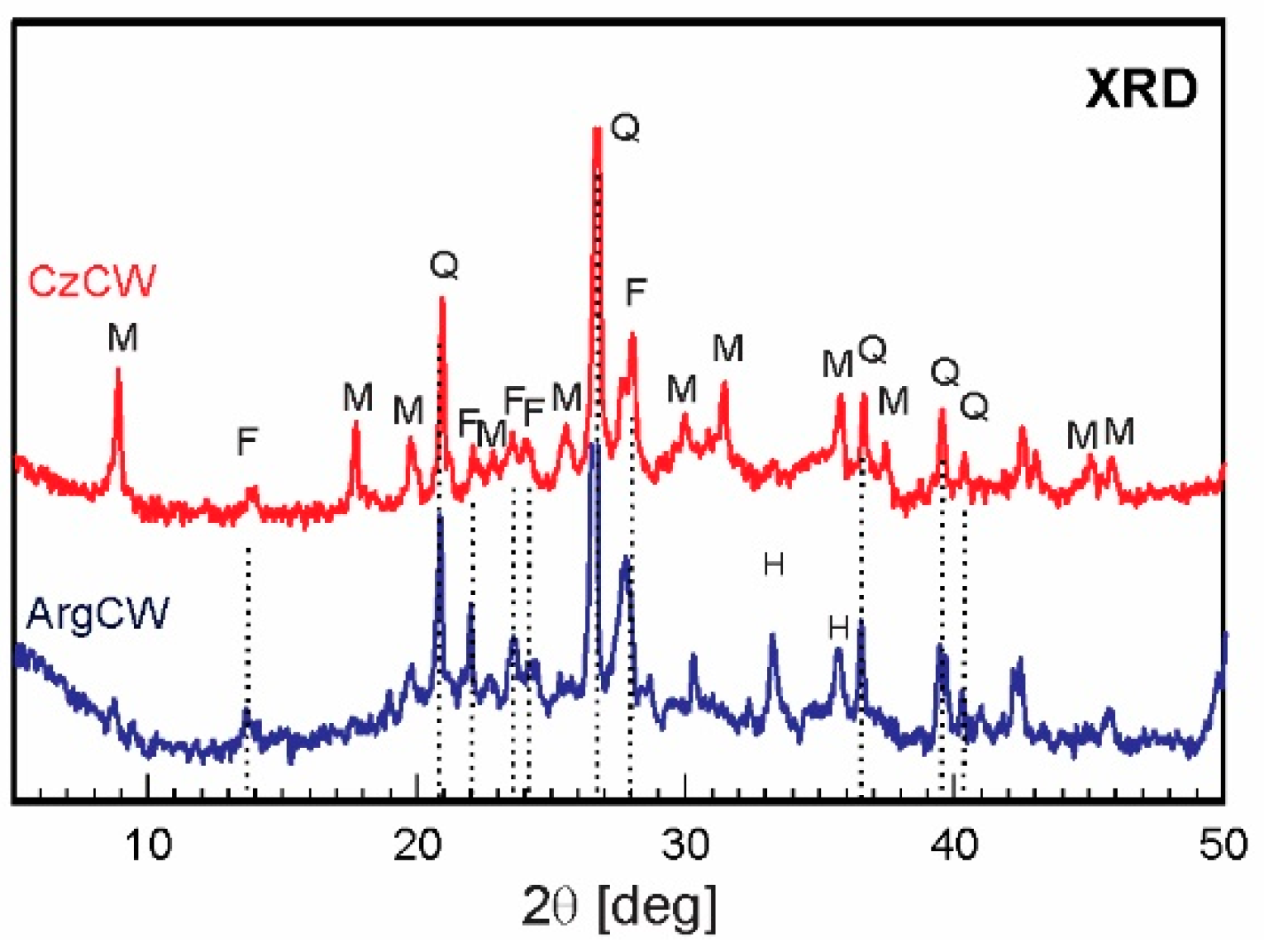
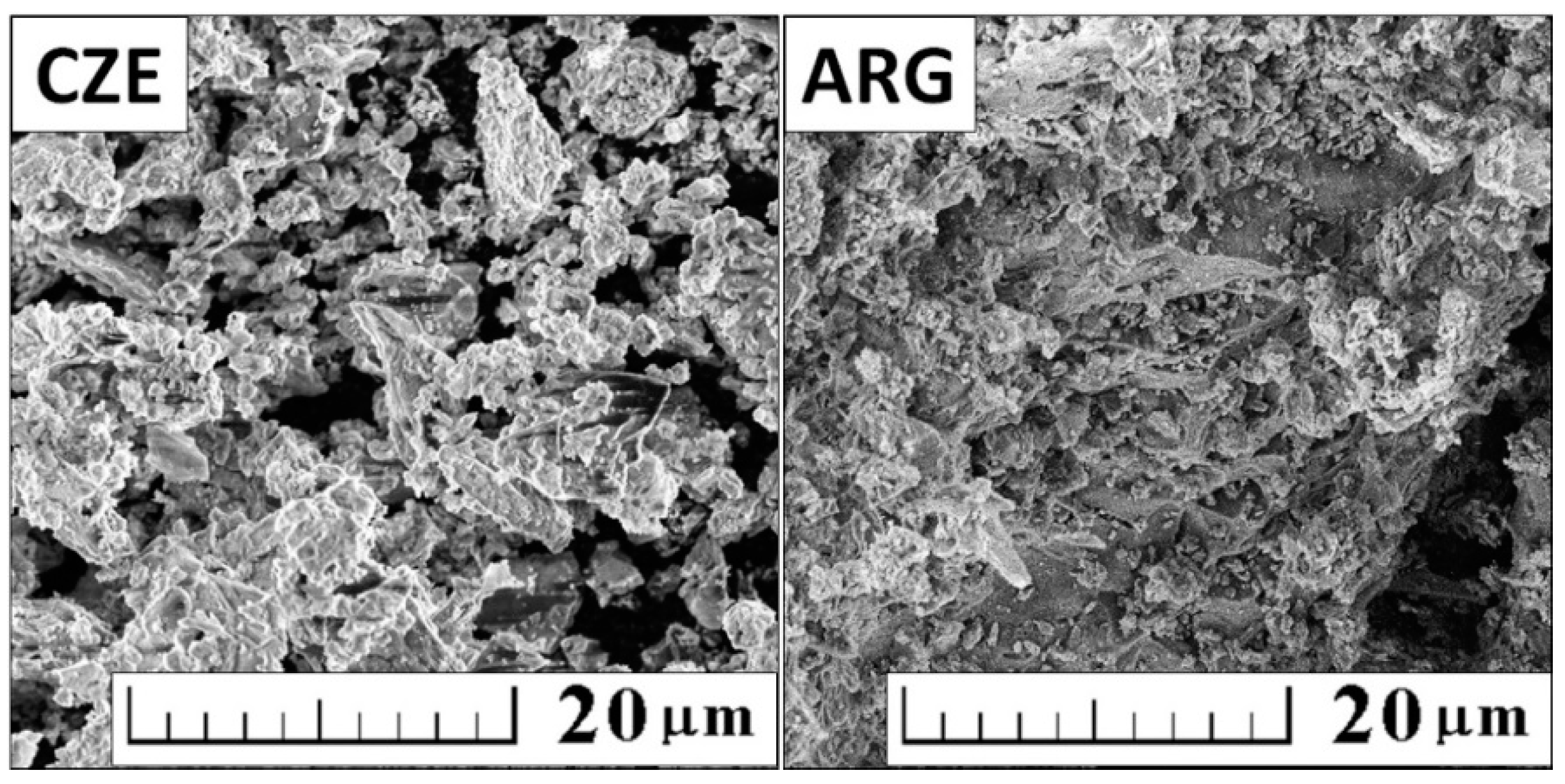
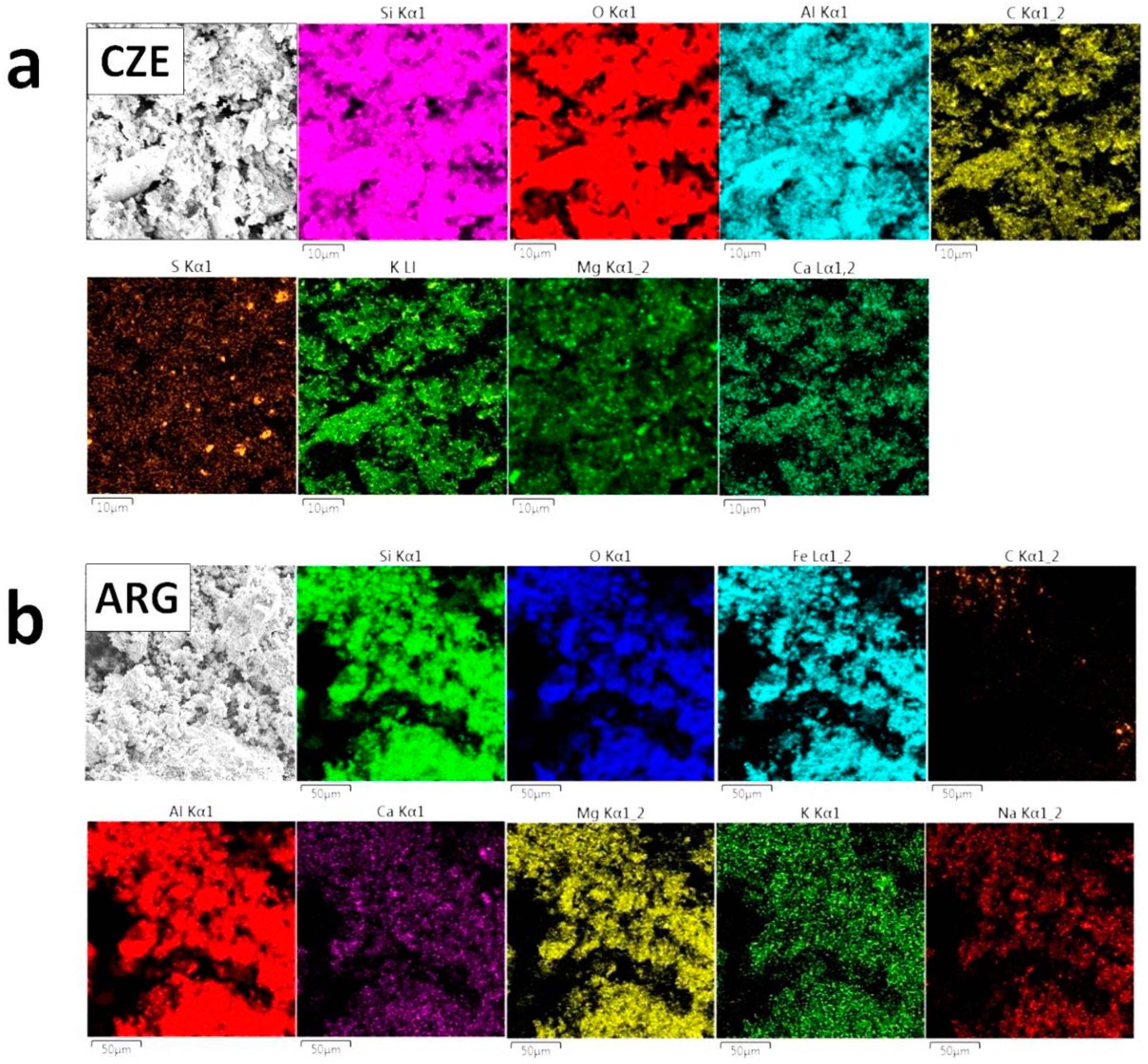
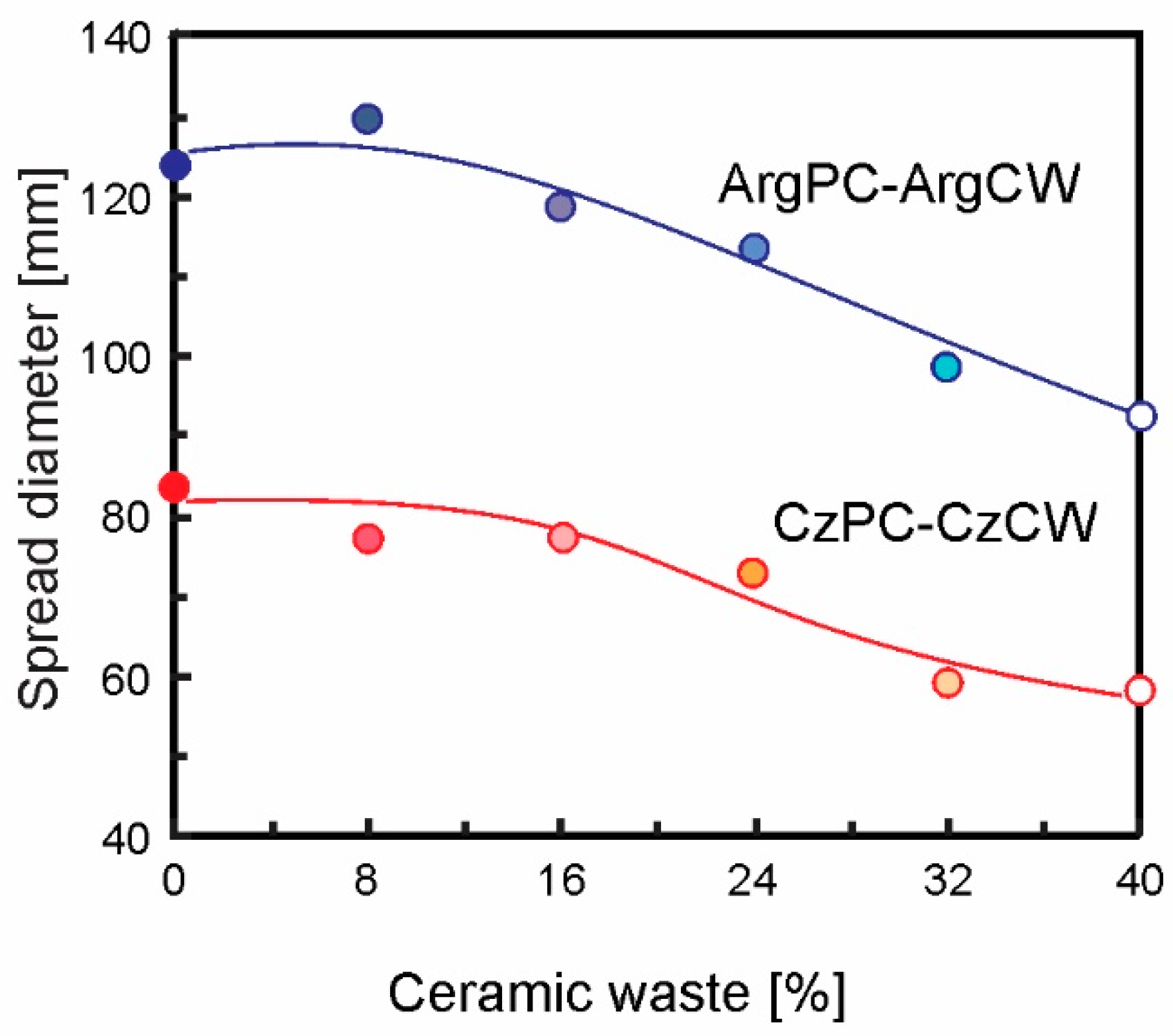
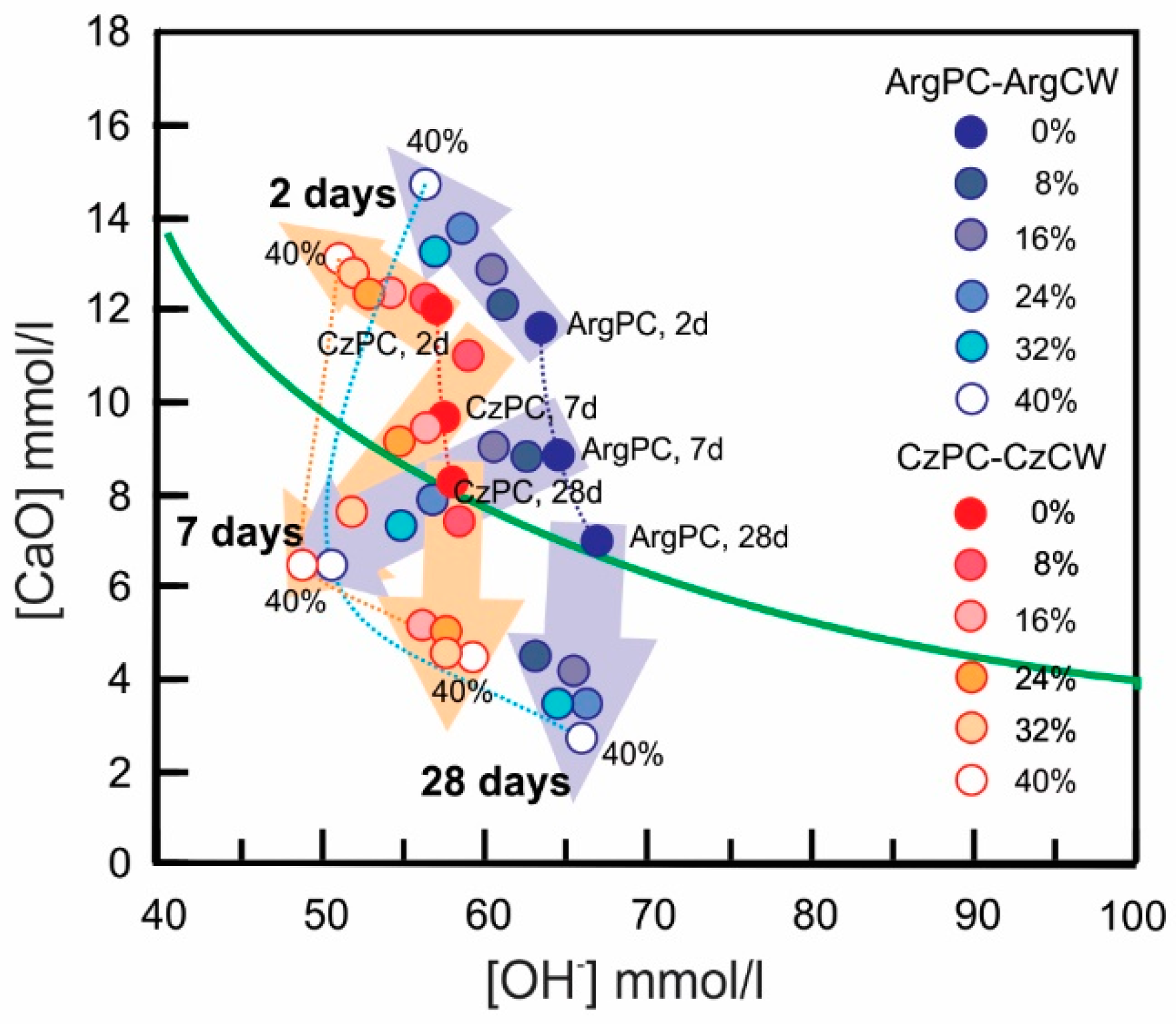


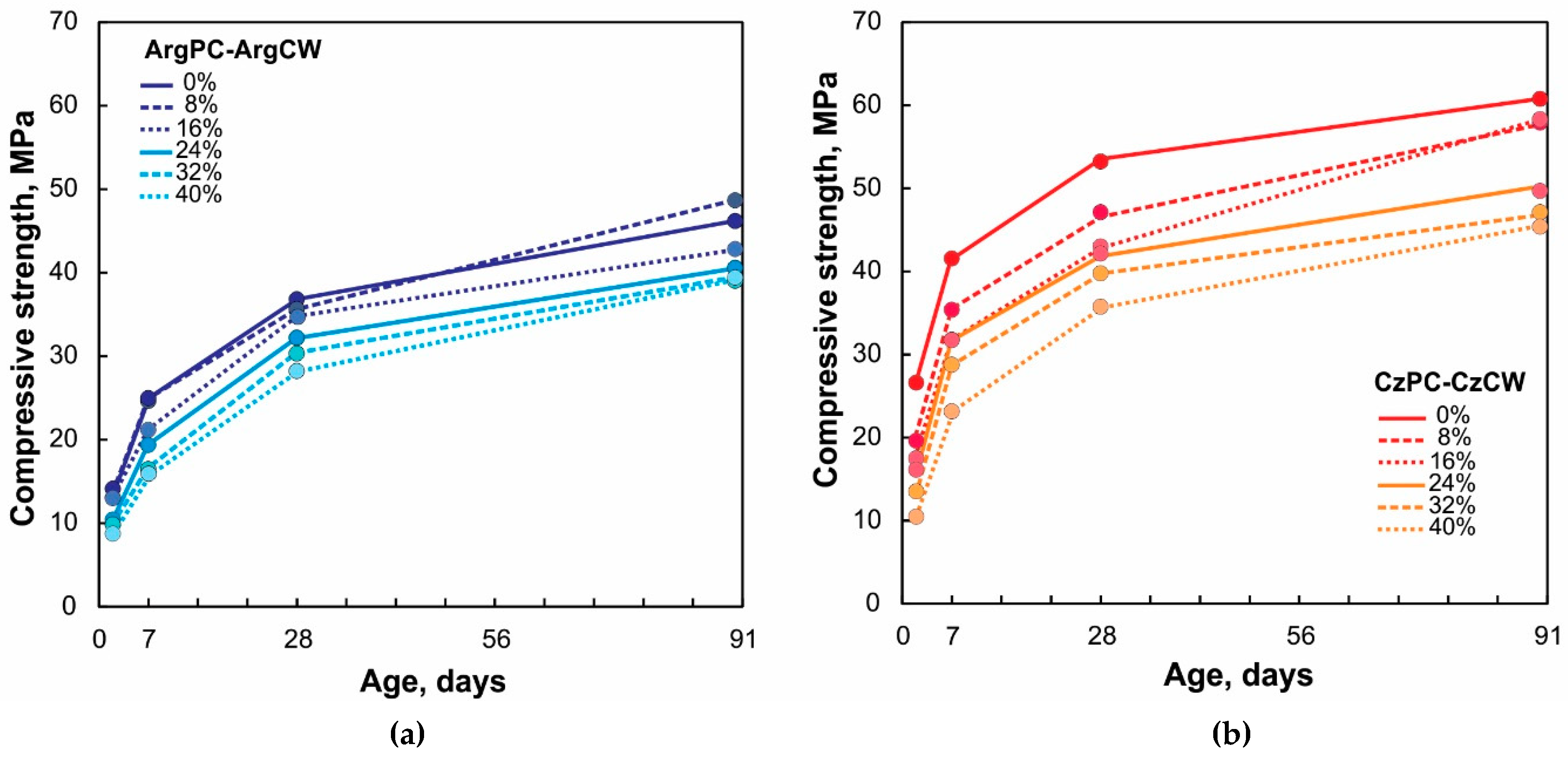
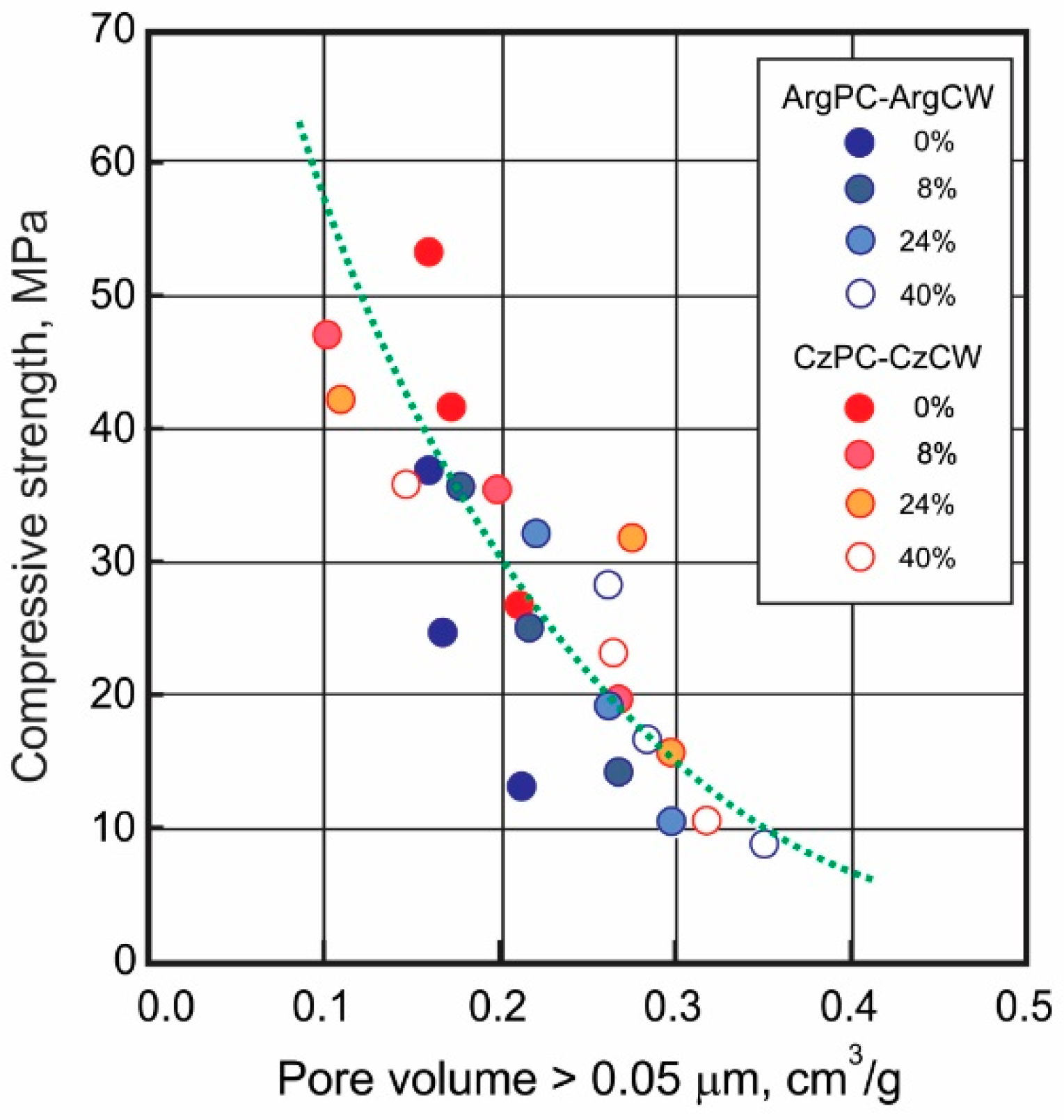

| Element/Compound | Portland Cement | Waste Ceramic Powder | ||
|---|---|---|---|---|
| ArgPC | CzPC | ArgCW | CzCW | |
| Chemical Composition, wt.% | ||||
| SiO2 | 21.5 | 18.9 | 64.6 | 51.3 |
| Al2O3 | 3.8 | 4.2 | 17 | 20 |
| Fe2O3 | 3.8 | 3.8 | 5.6 | 6 |
| CaO | 64.3 | 62.4 | 2.5 | 11.5 |
| MgO | 0.8 | 1 | 1.5 | 4.5 |
| SO3 | 2.6 | 2.3 | - | 1 |
| Na2O | 0.1 | 0.02 | 4.2 | 1.3 |
| K2O | 1.1 | 1.1 | 2.9 | 3.2 |
| TiO2 | - | 0.8 | 0.7 | 0.8 |
| LOI, % | 2.1 | 1.5 | 0.6 | 1.1 |
| Mineralogical Composition, wt.% | ||||
| Alite | 64 | 67 | - | - |
| Belite | 12 | 8 | - | - |
| Tricalcium Aluminate | 2.5 | 6.5 | - | - |
| Brownmerilleite | 12.5 | 7.5 | - | - |
| Calcite | 4.5 | 4 | - | - |
| Gypsum | 2.5 | 6 | - | - |
| Bassenite | 1 | - | - | |
| Arkanite | 0.5 | - | - | |
| Periclase | 0.6 | 0.8 | ||
| Amorphous fraction | 37.3 | 46.7 | ||
| Quartz | 30.5 | 23.6 | ||
| Feldspar | Anhortite | 28.6 | ||
| Albite | 6.5 | |||
| Microcline | 7.2 | |||
| Orthoclase | 2.8 | |||
| Mica | Biotite | - | 0.9 | |
| Muscovite | 2.6 | |||
| Other silicates | Akermanite | - | 4.4 | |
| Hedenbergerite | 3.8 | |||
| Hematite | 3.5 | 1.4 | ||
| Physical Properties | ||||
| Density, g/cm3 | 3.15 | 3.08 | 2.68 | 2.77 |
| SS Blaine, m2/kg | 315 | 330 | 590 | 665 |
| Water absorption, % | - | - | 0.68 | 0.46 |
| Particle size distribution parameters, μm | ||||
| d90 | 63.5 | 38.2 | 64.7 | 41 |
| d50 | 19 | 14.2 | 30.2 | 19.5 |
| d10 | 2.7 | 2.3 | 6 | 4.5 |
| Cement Blend | Argentine | Czech | ||
|---|---|---|---|---|
| ArgPC | ArgCW | CzPC | CzCW | |
| 0 CW | 100 | 0 | 100 | 0 |
| 8 CW | 92 | 8 | 92 | 8 |
| 16 CW | 84 | 16 | 84 | 16 |
| 24 CW | 76 | 24 | 76 | 24 |
| 32 CW | 68 | 32 | 68 | 32 |
| 40 CW | 60 | 40 | 60 | 40 |
| CW*% | Duration of First Valley, Min | Second Peak Parameters | Third Peak Parameters | Heat Released, J/g | ||||||||
|---|---|---|---|---|---|---|---|---|---|---|---|---|
| Cmax2 | tmax | Slope | Cmax3 | tmax | Cmax2/Cmax3 | 6 | 12 | 24 | 36 | 48 | ||
| mW/g | min | mW/g∙s | mW/g | min | h | |||||||
| ArgPC-ArgCW | ||||||||||||
| 0 | 130 | 1.39 | 840 | 0.00170 | - | - | - | 10.4 | 31.7 | 88.3 | 117.1 | 125.9 |
| 8 | 160 | 1.36 | 849 | 0.00178 | - | - | - | 9.0 | 28.7 | 84.0 | 110.4 | 117.5 |
| 16 | 170 | 1.23 | 842 | 0.00173 | 1.23 | 1001 | 1.00 | 9.2 | 27.8 | 74.5 | 99.3 | 108.9 |
| 24 | 160 | 1.06 | 806 | 0.00151 | 1.10 | 934 | 1.04 | 9.6 | 26.7 | 69.6 | 91.4 | 97.5 |
| 32 | 150 | 1.06 | 800 | 0.00156 | 1.10 | 927 | 1.04 | 8.6 | 25.6 | 68.7 | 88.5 | 94.3 |
| 40 | 210 | 0.75 | 770 | 0.00127 | 0.81 | 920 | 1.08 | 6.2 | 19.0 | 50.3 | 63.5 | 67.2 |
| CzPC-CzCW | ||||||||||||
| 0 | 210 | 1.33 | 848 | 0.00264 | 1.19 | 1128 | 0.89 | 15.9 | 32.9 | 84.9 | 114.5 | 122.3 |
| 8 | 215 | 1.30 | 848 | 0.00257 | 1.19 | 1138 | 0.92 | 16.2 | 32.9 | 84.8 | 116.6 | 124.9 |
| 16 | 250 | 1.15 | 848 | 0.00238 | 1.07 | 1133 | 0.93 | 15.4 | 30.3 | 77.7 | 109.9 | 113.8 |
| 24 | 250 | 1.11 | 837 | 0.00225 | 1.05 | 1092 | 0.95 | 14.5 | 29.7 | 74.2 | 101.7 | 108.6 |
| 32 | 270 | 1.08 | 822 | 0.00228 | 1.02 | 1031 | 0.94 | 14.5 | 29.3 | 73.8 | 99.1 | 105.5 |
| 40 | 290 | 0.90 | 822 | 0.00194 | 0.87 | 1123 | 0.97 | 13.5 | 25.5 | 63.4 | 83.8 | 88.6 |
| Age, days | CW, % | Specific Density, g/cm3 | Cumulative Pore Volume, cm3/g | Threshold Pore Diameter, μm | ||
|---|---|---|---|---|---|---|
| Total | <0.05 μm | >0.05 μm | ||||
| ArgPC-ArgCW | ||||||
| 2 | 0 | 2528 | 0.275 | 0.062 | 0.213 | 1.126 |
| 8 | 2568 | 0.329 | 0.066 | 0.263 | 1.479 | |
| 24 | 2538 | 0.359 | 0.062 | 0.297 | 1.720 | |
| 40 | 2597 | 0.411 | 0.060 | 0.351 | 2.641 | |
| 7 | 0 | 2342 | 0.234 | 0.066 | 0.168 | 0.224 |
| 8 | 2423 | 0.289 | 0.072 | 0.217 | 0.929 | |
| 24 | 2420 | 0.342 | 0.079 | 0.262 | 1.168 | |
| 40 | 2437 | 0.371 | 0.086 | 0.285 | 1.747 | |
| 28 | 0 | 2321 | 0.211 | 0.050 | 0.160 | 0.187 |
| 8 | 2356 | 0.246 | 0.068 | 0.178 | 0.670 | |
| 24 | 2395 | 0.291 | 0.070 | 0.221 | 0.749 | |
| 40 | 2422 | 0.343 | 0.081 | 0.262 | 1.203 | |
| CzPC-CzCW | ||||||
| 2 | 0 | 2509 | 0.275 | 0.062 | 0.213 | 0.915 |
| 8 | 2435 | 0.334 | 0.066 | 0.268 | 0.921 | |
| 24 | 2432 | 0.394 | 0.096 | 0.298 | 1.051 | |
| 40 | 2485 | 0.401 | 0.100 | 0.301 | 1.137 | |
| 7 | 0 | 2338 | 0.238 | 0.065 | 0.173 | 0.275 |
| 8 | 2297 | 0.284 | 0.085 | 0.199 | 0.364 | |
| 24 | 2339 | 0.360 | 0.084 | 0.276 | 0.978 | |
| 40 | 2407 | 0.366 | 0.101 | 0.265 | 1.156 | |
| 28 | 0 | 2308 | 0.211 | 0.051 | 0.160 | 0.194 |
| 8 | 2257 | 0.183 | 0.081 | 0.102 | 0.163 | |
| 24 | 2319 | 0.192 | 0.082 | 0.110 | 0.185 | |
| 40 | 2356 | 0.249 | 0.104 | 0.147 | 0.154 | |
| Age, Days | Phase | ArgPC-ArgCW | CzPC-CzCW | ||||||||||
|---|---|---|---|---|---|---|---|---|---|---|---|---|---|
| 0 | 8 | 16 | 24 | 32 | 40 | 0 | 8 | 16 | 24 | 32 | 40 | ||
| 2 | E * | ✓✓ ** | ✓✓ | ✓✓ | ✓✓ | ✓✓ | ✓✓ | ✓✓ | ✓✓ | ✓✓ | ✓✓ | ✓✓ | ✓✓ |
| Hc | |||||||||||||
| Mc | |||||||||||||
| CH | ✓✓✓ | ✓✓✓ | ✓✓✓ | ✓✓✓ | ✓✓✓ | ✓✓ | ✓✓✓ | ✓✓✓ | ✓✓✓ | ✓✓✓ | ✓✓✓ | ✓✓ | |
| 7 | E | ✓✓ | ✓✓ | ✓✓ | ✓✓ | ✓✓ | ✓✓ | ✓✓ | ✓✓ | ✓✓ | ✓✓ | ✓✓ | ✓✓ |
| Hc | ✓ | ✓ | ✓ | ✓✓ | ✓✓ | ✓ | ✓ | ✓✓ | ✓✓ | ✓✓ | ✓✓ | ||
| Mc | |||||||||||||
| CH | ✓✓✓ | ✓✓✓ | ✓✓✓ | ✓✓✓ | ✓✓✓ | ✓✓ | ✓✓✓ | ✓✓✓ | ✓✓✓ | ✓✓✓ | ✓✓✓ | ✓✓ | |
| 28 | E | ✓✓ | ✓✓ | ✓✓ | ✓✓ | ✓✓ | ✓✓ | ✓✓ | ✓✓ | ✓✓ | ✓✓ | ✓✓ | ✓✓ |
| Hc | ✓ | ✓ | ✓ | ✓ | ✓ | ✓ | ✓ | ✓ | ✓ | ✓✓ | ✓✓ | ✓✓✓ | |
| Mc | ✓ | ✓ | ✓ | ✓✓ | ✓✓ | ✓ | ✓ | ✓ | ✓✓ | ✓✓ | |||
| CH | ✓✓✓ | ✓✓✓ | ✓✓✓ | ✓✓✓ | ✓✓ | ✓✓ | ✓✓✓ | ✓✓✓ | ✓✓✓ | ✓✓✓ | ✓✓ | ✓✓ | |
| 90 | E | ✓✓ | ✓✓ | ✓✓ | ✓✓ | ✓✓ | ✓✓ | ✓✓ | ✓✓ | ✓✓ | ✓✓ | ✓✓ | ✓✓ |
| Hc | ✓ | ✓ | ✓ | ✓ | ✓ | ✓ | ✓ | ✓ | ✓ | ✓✓ | ✓✓ | ||
| Mc | ✓✓ | ✓✓ | ✓✓✓ | ✓✓✓ | ✓✓✓ | ✓✓ | ✓✓ | ✓✓ | ✓✓ | ✓✓✓ | ✓✓✓ | ||
| CH | ✓✓✓ | ✓✓✓ | ✓✓✓ | ✓✓✓ | ✓✓ | ✓✓ | ✓✓✓ | ✓✓✓ | ✓✓ | ✓✓ | ✓✓ | ✓✓ | |
| 360 | E | ✓✓ | ✓✓ | ✓✓ | ✓✓ | ✓✓ | ✓✓ | ✓✓ | ✓✓ | ✓✓ | ✓✓ | ✓✓ | ✓✓ |
| Hc | |||||||||||||
| Mc | ✓✓ | ✓✓ | ✓✓ | ✓✓✓ | ✓✓✓ | ✓✓✓ | ✓✓ | ✓✓✓ | ✓✓✓ | ✓✓✓ | ✓✓✓ | ✓✓✓ | |
| CH | ✓✓✓ | ✓✓✓ | ✓✓✓ | ✓✓✓ | ✓✓ | ✓✓ | ✓✓✓ | ✓✓✓ | ✓✓ | ✓✓ | ✓✓ | ✓✓ | |
© 2019 by the authors. Licensee MDPI, Basel, Switzerland. This article is an open access article distributed under the terms and conditions of the Creative Commons Attribution (CC BY) license (http://creativecommons.org/licenses/by/4.0/).
Share and Cite
Rahhal, V.F.; Trezza, M.A.; Tironi, A.; Castellano, C.C.; Pavlíková, M.; Pokorný, J.; Irassar, E.F.; Jankovský, O.; Pavlík, Z. Complex Characterization and Behavior of Waste Fired Brick Powder-Portland Cement System. Materials 2019, 12, 1650. https://doi.org/10.3390/ma12101650
Rahhal VF, Trezza MA, Tironi A, Castellano CC, Pavlíková M, Pokorný J, Irassar EF, Jankovský O, Pavlík Z. Complex Characterization and Behavior of Waste Fired Brick Powder-Portland Cement System. Materials. 2019; 12(10):1650. https://doi.org/10.3390/ma12101650
Chicago/Turabian StyleRahhal, Viviana Fátima, Mónica Adriana Trezza, Alejandra Tironi, Claudia Cristina Castellano, Milena Pavlíková, Jaroslav Pokorný, Edgardo Fabian Irassar, Ondřej Jankovský, and Zbyšek Pavlík. 2019. "Complex Characterization and Behavior of Waste Fired Brick Powder-Portland Cement System" Materials 12, no. 10: 1650. https://doi.org/10.3390/ma12101650
APA StyleRahhal, V. F., Trezza, M. A., Tironi, A., Castellano, C. C., Pavlíková, M., Pokorný, J., Irassar, E. F., Jankovský, O., & Pavlík, Z. (2019). Complex Characterization and Behavior of Waste Fired Brick Powder-Portland Cement System. Materials, 12(10), 1650. https://doi.org/10.3390/ma12101650








